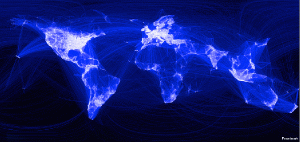By Caitlin Clevenger, caclevenger@vassar.edu
“Apple is a schizophrenic company: a self-professed revolutionary closely allied with both of the greatest forces of information, the entertainment conglomerates and the telecommunications industry”, writes Tim Wu in The Master Switch (273).
Of Microsoft, he writes, “Even if Windows was never as advanced or well designed as Apple’s operating system, it enjoyed one insuperable advantage: it worked on any computer, supported just about every type of software, and could interface with any printer, modem, or whatever other hardware one could design” (279).
The Microsoft-Apple feud has become a major staple of American culture. More so than your choice of Verizon over AT&T, your choice of cable television over satellite, or even your choice of Pepsi over Coke, your choice of Mac over PC classifies you and tells the world something about your personality.
This is now:
This is then:
Apple started as a revolutionary company- this was not just a marketing strategy. In 1983, IBM (running a Microsoft OS) and Commodore owned the lion’s share of the market, and the Apple II had just 8%. But in 1984, it created the Macintosh and ran this ad during the Super Bowl.
It was the first major computer with a desktop interface- the icons and mouse we’ve come to know and love. Apple had sacrificed open-source programming and open architecture for user-friendliness. This has been its policy ever since. But what this has meant for Apple has been vertical integration. No one but Apple can make a Mac OS compatible computer, and there are severe limitations on how much you can alter the code on any Apple product. This is why there are no Mac viruses, and also why there are companies who make a profit off of “jailbreaking” iPhones.
It’s also why by the 1990’s, Apple products were failing. I would go into my elementary school computer class, filled with Macintoshes, and groan in frustration when I couldn’t right-click, or bring in the PC game that had come with my cereal box.
In 1997, Macintoshes accounted for just 3% of all computers sold, and PC’s accounted for the other 97%. Apple was close to failing when, at a conference, Steve Jobs revealed a groundbreaking partnership.
Had Apple failed, Microsoft would have held a monopoly and likely been broken up by antitrust laws. By adding an infusion of capital to Apple, Microsoft saved its own majority status. Apple, in order to save its company, stopped fighting Microsoft, but instead welcomed it.
PCs still account for the majority share in personal computers, but Apple owns the market in MP3 players (75% in 2008, versus Microsoft’s 3%). Apple has almost triple Microsoft’s share in the Smartphone market. Macs have a huge share among young consumers, too, so much so that Vassar students with PCs stand out and in effect become rebels. It seems as if Microsoft and Apple, as the only remaining players in the computer game, have entered into a cycle in which they will inevitably reverse roles. Is Apple’s 25 year marketing strategy as a rebel company expiring?

